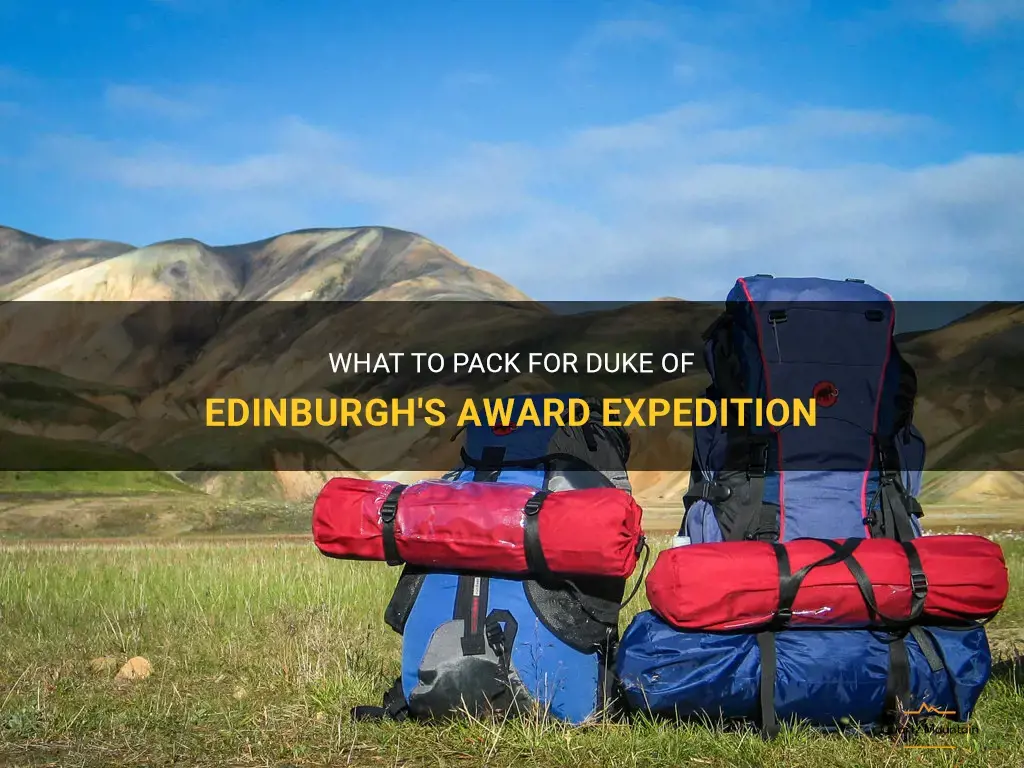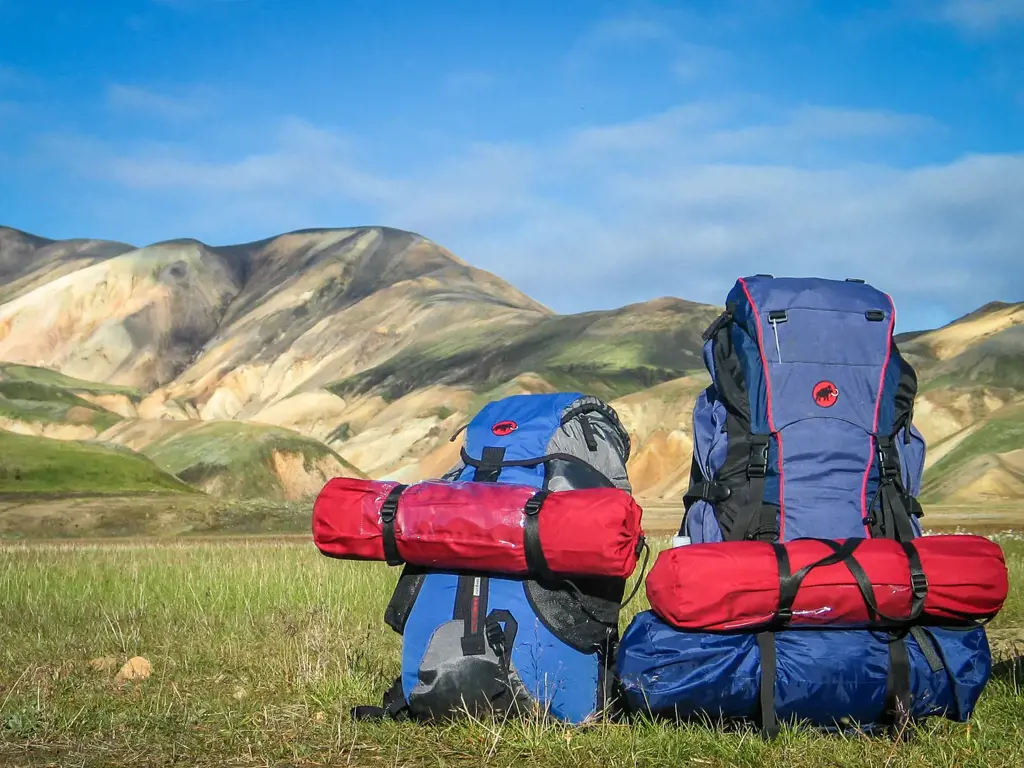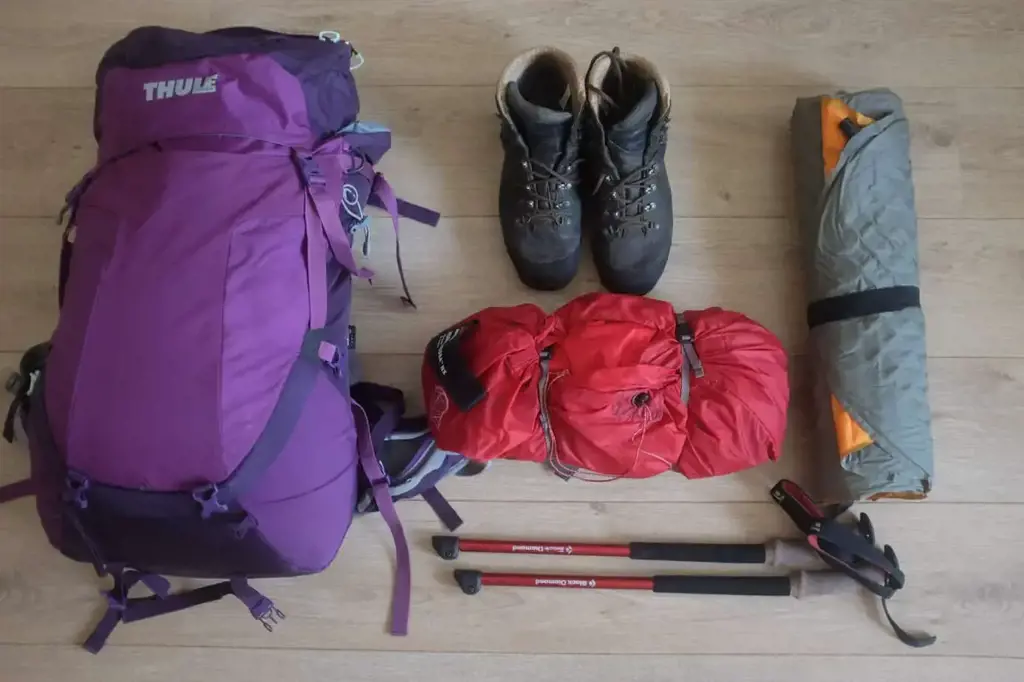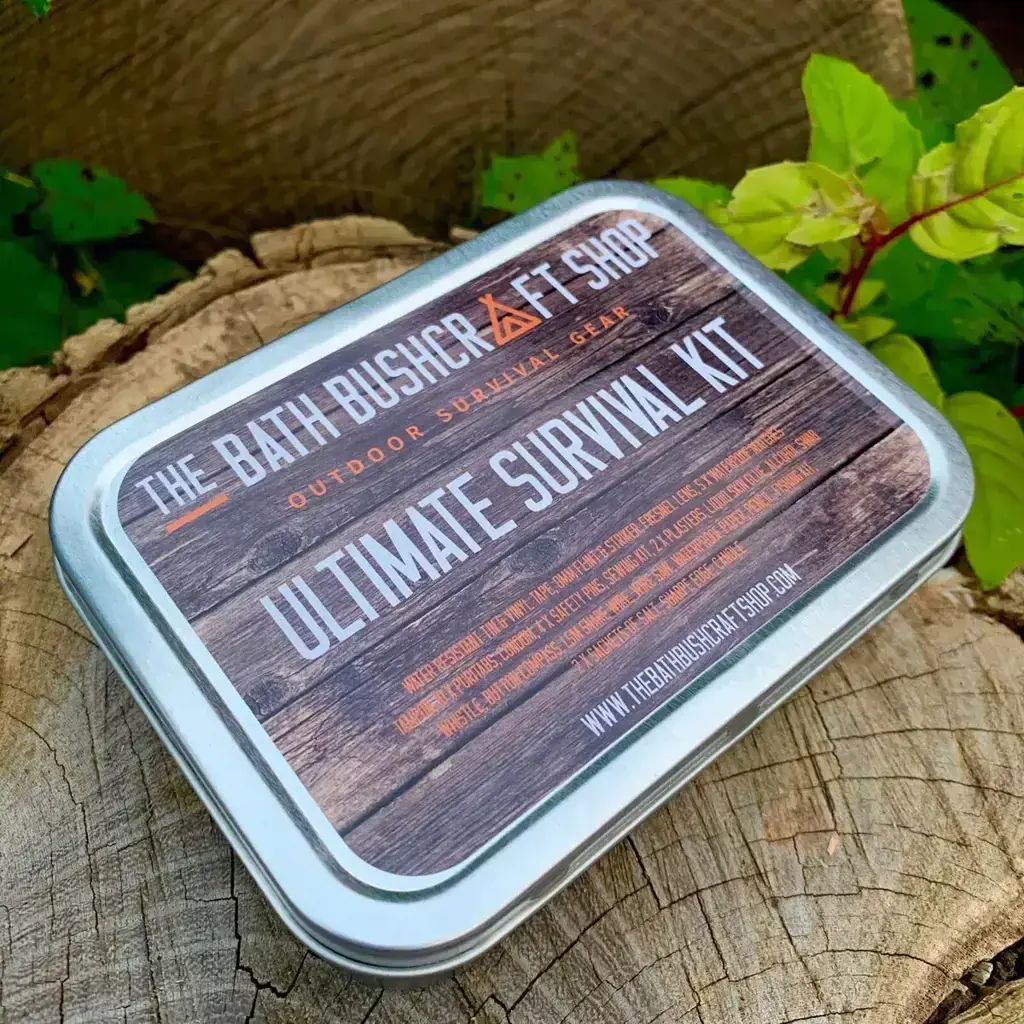
Are you preparing for a Duke of Edinburgh's Award expedition and unsure about what to pack? Look no further! In this guide, we will give you all the essential items you need to pack for a successful and enjoyable trip. Whether you are embarking on a hiking, biking, or camping adventure, we have got you covered. So, don't stress, just follow our packing tips and get ready for an unforgettable expedition!
| Characteristics | Values |
|---|---|
| Clothing | - Waterproof jacket |
| - Waterproof trousers | |
| - Hiking boots | |
| - Wicking base layers | |
| - Mid-layer | |
| - Hat and gloves | |
| - Extra socks | |
| Navigation Equipment | - Map |
| - Compass | |
| - GPS device | |
| - Whistle | |
| - Watch | |
| - Headlamp | |
| Food | - Lightweight stove |
| - Cooking utensils | |
| - Freeze-dried meals | |
| - Energy bars | |
| - Snacks | |
| - Water bottles | |
| First Aid Kit | - Plasters |
| - Bandages | |
| - Antiseptic cream | |
| - Painkillers | |
| - Tweezers | |
| - Safety pins | |
| Shelter | - Tent |
| - Sleeping bag | |
| - Sleeping mat | |
| - Pillow | |
| - Bivvy bag | |
| - Groundsheet | |
| Personal Items | - Toiletries |
| - Towel | |
| - Sunscreen | |
| - Insect repellent | |
| - Camping stove | |
| - Utensils | |
| Equipment Repair | - Duct tape |
| - Multi-tool | |
| - Spare batteries | |
| - Ropes/cord | |
| - Zip ties | |
| - Repair patches | |
| Emergency Communication | - Mobile phone |
| - Portable charger | |
| - Signal mirror | |
| - Flares | |
| - Emergency blanket | |
| - Whistle |
What You'll Learn
- What are the essential items to pack for a Duke of Edinburgh's Award expedition?
- How should I prioritize and organize my packing list for a DofE trip?
- Are there any specific clothing or footwear recommendations for a DofE expedition?
- What equipment and supplies should I bring for cooking and food preparation during a DofE expedition?
- Are there any recommended safety gear or emergency supplies that should be included in my packing list for a DofE trip?

What are the essential items to pack for a Duke of Edinburgh's Award expedition?

The Duke of Edinburgh's Award is a popular youth development program that aims to promote independence and resilience among young people. One of the key components of the award is the expedition, where participants undertake a challenging journey in the great outdoors. Whether you're embarking on a short hike or a multi-day trek, it's essential to pack the right gear. Here are some essential items to consider for a Duke of Edinburgh's Award expedition:
- Backpack: Invest in a sturdy, comfortable backpack that is large enough to fit all your gear but not too heavy to carry for long periods. Look for one with adjustable straps and plenty of compartments for organizing your essentials.
- Hiking boots: A good pair of hiking boots is crucial for traversing different terrains. Make sure they are comfortable, well-fitting, and provide ankle support. Break them in before your expedition to avoid blisters.
- Clothing: Dress in layers to regulate your body temperature. Pack lightweight, moisture-wicking base layers, insulating mid-layers, and a waterproof shell to protect against rain and wind. Don't forget a hat, gloves, and a buff or scarf to keep your extremities warm.
- Sleeping bag and mat: Choose a sleeping bag appropriate for the expected weather conditions. Look for one with a temperature rating lower than the expected minimum temperature. A lightweight sleeping mat will provide insulation and cushioning for a more comfortable night's sleep.
- Stove and cookware: If you're planning on cooking your own meals, a lightweight camping stove and cookware are essential. Opt for a stove that uses fuel canisters and a compact set of pots and pans that nest together for easy packing.
- Navigation tools: A map and compass are necessary for navigating in the wilderness. Learn how to use them before your expedition or consider taking a navigation course. Additionally, a GPS device or smartphone with GPS capabilities can be a helpful backup.
- First aid kit: Accidents can happen even on a well-planned expedition. Pack a comprehensive first aid kit that includes bandages, antiseptic wipes, pain medication, and any personal medications you may need.
- Hydration system: Staying hydrated is crucial during outdoor activities. Use a hydration bladder or water bottles to carry an adequate water supply. Consider adding water purification tablets or a filter as a backup in case you run out of clean water.
- Multi-tool: A multi-tool with a knife, scissors, pliers, and other tools can come in handy for various tasks such as repairing gear, preparing food, or building emergency shelters.
- Personal items: Don't forget to pack essentials such as a headlamp or flashlight, extra batteries, sunscreen, insect repellent, a whistle, a lightweight towel, and toiletries. Also, pack a small lightweight sack for carrying waste and leave no trace.
Remember to pack your gear strategically, distributing the weight evenly in your backpack. Test your equipment before your expedition to ensure everything is in working order. Lastly, make sure to familiarize yourself with the rules and guidelines of the Duke of Edinburgh's Award regarding gear requirements.
Essential Items for Your Summer Trip to Chamonix: What to Pack
You may want to see also

How should I prioritize and organize my packing list for a DofE trip?

When it comes to packing for a Duke of Edinburgh (DofE) trip, it is essential to prioritize and organize your packing list effectively. Being well-prepared with the right gear and supplies can make your trip more enjoyable and ensure your safety in the great outdoors. In this article, we will discuss step-by-step how to prioritize and organize your packing list for a DofE trip using scientific principles and real-life experiences.
Step 1: Research and understand the requirements
The first step in prioritizing and organizing your packing list is to research and understand the requirements of the DofE trip you'll be embarking on. This could include the duration of the trip, the expected weather conditions, the type of activities involved, and any specific gear or equipment that is recommended or required. By knowing the specific requirements, you can focus on packing the essentials and avoid unnecessary items that will only weigh you down.
Step 2: Create a checklist
Next, create a checklist of all the items you will need for your DofE trip. This should include clothing, camping gear, cooking equipment, navigation tools, personal hygiene items, and any other essentials. Organize the checklist into categories to make it easier to pack and keep track of your items.
Step 3: Prioritize the essentials
Once you have your checklist, prioritize the essentials that are crucial for your trip. These are items that you cannot do without and are necessary for your safety and well-being. For example, a good quality tent, a warm sleeping bag, sturdy hiking boots, and a reliable map and compass are all essential items for an outdoor adventure. Focus on packing these items first as they are the most important for your trip.
Step 4: Consider weight and space
When organizing your packing list, it is important to consider the weight and space limitations of your backpack. Choose lightweight and compact items whenever possible to maximize your comfort and mobility during the trip. For example, opt for a lightweight stove and cookware, compact sleeping gear, and clothing made from lightweight and quick-drying materials.
Step 5: Plan for contingencies
In addition to the essentials, it is important to plan for contingencies and emergencies. This could include packing a first aid kit, emergency shelter, extra food and water, and communication devices such as a whistle or a satellite phone. It's better to be over-prepared than underprepared when it comes to potential emergencies in the wilderness.
Step 6: Test and refine your packing list
Before heading out on your DofE trip, it is crucial to test and refine your packing list. Take your gear for a test run on shorter hikes or camping trips to ensure everything works as expected and to make any necessary adjustments. This will help you identify any missing items or gear that needs to be replaced or upgraded.
Step 7: Learn from experience
Once you have completed your DofE trip, take the time to reflect on your packing list. Assess what worked well and what could be improved for future trips. Every outdoor adventure is a learning experience, and each trip will help you refine and optimize your packing list further.
In conclusion, prioritizing and organizing your packing list for a DofE trip is crucial for a successful and enjoyable experience. By researching the requirements, creating a checklist, prioritizing the essentials, considering weight and space, planning for contingencies, testing and refining your gear, and learning from experience, you can ensure that you are prepared and well-equipped for your outdoor adventure. Remember to pack smart, pack light, and pack for safety.
Essential Items to Pack for Exploring London and Paris
You may want to see also

Are there any specific clothing or footwear recommendations for a DofE expedition?

When it comes to embarking on a Duke of Edinburgh (DofE) expedition, it is important to be well-prepared with the right clothing and footwear. The DofE expeditions often involve challenging terrains and varying weather conditions, so it is crucial to choose suitable gear that will keep you comfortable and protected throughout your journey. In this article, we will discuss some specific recommendations for clothing and footwear for a DofE expedition.
Layering system:
A well-thought-out layering system is essential for staying comfortable in changing weather conditions. It consists of three main layers: a base layer, an insulation layer, and a shell layer. The base layer should be made of moisture-wicking material such as merino wool or synthetic fabric to keep you dry. The insulation layer should provide warmth and can be a fleece or a down jacket. The shell layer should be waterproof and breathable to protect you from rain or snow. This layering system allows you to adapt to changing temperatures by adding or removing layers accordingly.
Lightweight and quick-drying clothing:
Opt for lightweight and quick-drying clothing to minimize the weight in your backpack and ensure that you stay dry even if you encounter rain, sweat, or river crossings. Look for materials like nylon or polyester that dry quickly and have moisture-wicking properties. Avoid cotton as it retains moisture and takes longer to dry, causing discomfort and potential hypothermia in cold conditions.
Hiking boots:
Invest in a pair of sturdy and comfortable hiking boots that provide ankle support and have a good grip on various terrains. Look for boots that are waterproof, breathable, and have a durable sole. Make sure to break in your boots before the expedition to prevent blisters and discomfort on the trail.
Socks:
Choose high-quality hiking socks made of wool or synthetic materials that wick away moisture and prevent blisters. Avoid cotton socks as they retain moisture and can cause friction.
Gaiters:
Consider wearing gaiters, which are protective coverings worn over boots and lower legs. They provide extra protection against mud, water, and vegetation, keeping your boots and feet dry and clean.
Hats and gloves:
Pack a warm hat and gloves to protect your extremities from cold temperatures. Look for hats that cover your ears and gloves that provide insulation without compromising dexterity.
Waterproof and breathable outer shell:
Having a waterproof and breathable jacket and pants is crucial to protect you from rain and wind while allowing sweat to escape. Look for gear that is specifically designed for outdoor activities and has sealed seams to prevent water leakage.
UV Protection:
Don't forget to protect yourself from UV rays by wearing a wide-brimmed hat, sunglasses, and applying sunscreen to exposed skin. UV protection is essential, even on cloudy days when the sun's rays can still reach you.
In addition to these specific recommendations, it is important to consider the specific requirements and regulations set by your DofE expedition coordinator. They may have additional recommendations or restrictions based on the location and time of the year. It is always a good idea to consult with experienced hikers or outdoor retailers to get expert advice on the best clothing and footwear options for your DofE expedition.
To summarize, choosing the right clothing and footwear for a DofE expedition is crucial for comfort, protection, and overall success. Opt for a layering system, lightweight and quick-drying clothing, sturdy hiking boots, quality socks, gaiters, hats, gloves, waterproof and breathable outer shell, and UV protection. Remember to consider the specific requirements of your expedition and seek expert advice when needed. With the right gear, you can confidently embark on your DofE expedition and enjoy the journey to its fullest.
Essential Items to Pack for ASU's E2 Camp
You may want to see also

What equipment and supplies should I bring for cooking and food preparation during a DofE expedition?

When preparing for a DofE expedition, it's important to make sure you have all the necessary equipment and supplies for cooking and food preparation. Here are some key items you should consider bringing:
- Stove: A lightweight and compact camping stove is essential for cooking meals on the go. Look for a stove that runs on gas or liquid fuel, as they are easier to use and more efficient.
- Cooking pot: A durable and lightweight cooking pot is necessary for boiling water and cooking food. Choose a pot with a lid and insulated handles for easy handling.
- Utensils: Bring a set of utensils including a spoon, fork, and knife. Opt for lightweight and foldable utensils to save space in your backpack.
- Plates and bowls: While you can eat straight from the cooking pot, it's a good idea to have separate plates and bowls for hygiene purposes. Look for lightweight and stackable options.
- Water bottles: Stay hydrated during your expedition by bringing several water bottles. Choose ones that are lightweight and durable.
- Water filter or purification tablets: Depending on your location, you might need to filter or purify water before drinking it. A portable water filter or purification tablets can come in handy.
- Food storage containers: Bring a few airtight containers to store leftovers or dry food items. This will help prevent spoilage and keep your food fresh.
- Cooking oil: A small bottle of cooking oil can be useful for frying or sautéing food. Opt for a sturdy plastic or metal bottle to prevent leakage.
- Spices and condiments: While not essential, bringing small containers of your favorite spices and condiments can add flavor to your meals. Consider salt, pepper, and some dried herbs.
- Cleaning supplies: To maintain good hygiene, pack some biodegradable soap, a sponge, and a small towel for cleaning your utensils and cooking equipment.
- Lightweight food options: Choose lightweight and non-perishable food items for your trip. This could include dehydrated meals, energy bars, nuts, dried fruits, and instant noodles.
- Personal preference items: Don't forget to bring any personal preference items such as tea bags, coffee, or hot chocolate if you enjoy them. These small treats can boost morale during long days of hiking.
When packing your equipment and supplies, make sure to distribute the weight evenly in your backpack to avoid strain or discomfort. It's also a good idea to practice using your cooking equipment and preparing meals before your expedition, so you are familiar with the process and can make any necessary adjustments.
Remember to follow leave-no-trace principles and properly dispose of any waste generated during your trip. With the right equipment and supplies, you'll be well-prepared for cooking and food preparation during your DofE expedition.
Essential Items to Pack for an Unforgettable Camping Experience
You may want to see also

Are there any recommended safety gear or emergency supplies that should be included in my packing list for a DofE trip?

When you embark on a Duke of Edinburgh (DofE) trip, it is essential to prioritize safety. This means packing the right gear and emergency supplies to ensure you are prepared for any situation that may arise. Here are some recommended safety gear and emergency supplies you should include in your packing list for a DofE trip:
- First Aid Kit: A compact first aid kit is a must-have for any outdoor adventure. It should include essentials such as plasters, bandages, antiseptic wipes, adhesive tape, scissors, and pain relief medication. Make sure to familiarize yourself with how to use the items in the kit before your trip.
- Emergency Shelter: It's always wise to carry a lightweight emergency shelter, such as a bivvy bag or a emergency blanket. These can provide essential protection from the elements in case of unexpected weather changes or if you get lost. Make sure your shelter is easy to set up and pack away quickly.
- Navigation Equipment: Even if you are familiar with the area, it's always a good idea to bring navigation equipment. This may include a map, compass, and GPS device. Familiarize yourself with how to use these tools before your trip, as they are essential for ensuring you stay on track and find your way if you become disorientated.
- Communication Devices: Depending on the nature of your trip and the area you'll be exploring, it is advisable to bring communication devices. This may include a mobile phone with a fully charged battery, a portable charger, and a whistle for attracting attention in case of an emergency. Check if there is mobile network coverage in the area you'll be traveling to ensure you have a means of communication if needed.
- Headlamp: A reliable headlamp with spare batteries is a vital piece of gear for a DofE trip, especially if you plan on camping overnight or exploring in low-light conditions. It will provide you with hands-free illumination, allowing you to navigate safely and perform tasks in the dark.
- Waterproof Clothing: Regardless of the weather forecast, it is crucial to pack waterproof clothing. This includes a waterproof jacket, pants, and footwear. They will protect you from rain, wind, and cold, and help prevent hypothermia if you get wet.
- Extra Food and Water: Carry extra food and water to sustain yourself in the event of an unexpected delay or emergency situation. Aim for lightweight and high-energy options that are easy to eat on the go, such as energy bars, nuts, and dried fruits. Water purification tablets or a water filter can also be useful in case you run out of clean water sources.
- Multi-tool: A multi-tool is a versatile and compact tool that can come in handy in various situations. Look for one that includes essential tools like a knife, pliers, screwdriver, and bottle opener. It can be used for tasks such as cutting, repairing equipment, and opening cans.
- Personal Protective Equipment: Consider the specific activities you'll be engaging in and pack the necessary personal protective equipment. This may include a helmet for cycling or climbing, gloves for handling equipment, and sunglasses to protect your eyes from the sun.
- Emergency Contact Information: It is crucial to carry emergency contact information, including the details of your group members, DofE leaders, and any relevant emergency services. Store this information in a waterproof container or bag and keep it easily accessible.
Remember, this is not an exhaustive list, and you should tailor your packing list to the specific conditions and requirements of your trip. It's essential to assess the potential risks and challenges you may encounter and pack accordingly. Additionally, ensure you are adequately trained in using the gear and emergency supplies you bring with you to maximize their effectiveness. Stay safe and enjoy your DofE adventure!
Essential Gear to Pack for Big White Ski Resort
You may want to see also
Frequently asked questions
- Some essential items to pack for your DofE expedition include a tent, sleeping bag, sleeping mat, sturdy walking boots, waterproof clothing (such as a jacket and trousers), a good quality backpack, a compass, a map, a first aid kit, a water bottle, and enough food to last you for the duration of your expedition.
- It's recommended to pack at least two sets of clothes for your DofE expedition. This way, you can have one set of clothes to wear while the other set dries after washing. Make sure to pack lightweight and quick-drying clothing items to minimize weight and maximize comfort.
- While you should pack enough food to last you for the duration of your DofE expedition, it's always a good idea to pack some extra snacks or emergency food in case of unexpected situations, such as getting lost or running out of food. Energy bars, dried fruit, and nuts are great options for lightweight and high-energy snacks.
- It's essential to pack sturdy and comfortable walking boots for your DofE expedition. Make sure your boots are broken in and have good ankle support. It's also a good idea to pack a spare pair of lightweight shoes or sandals to wear in camp to give your feet a break and allow them to breathe.
- The need to bring a stove for your DofE expedition will depend on the specific rules and guidelines set by your DofE group or instructor. Some groups may require participants to bring their own stove for cooking meals, while others may provide group cooking equipment. It's best to check with your DofE group or instructor for specific requirements.







